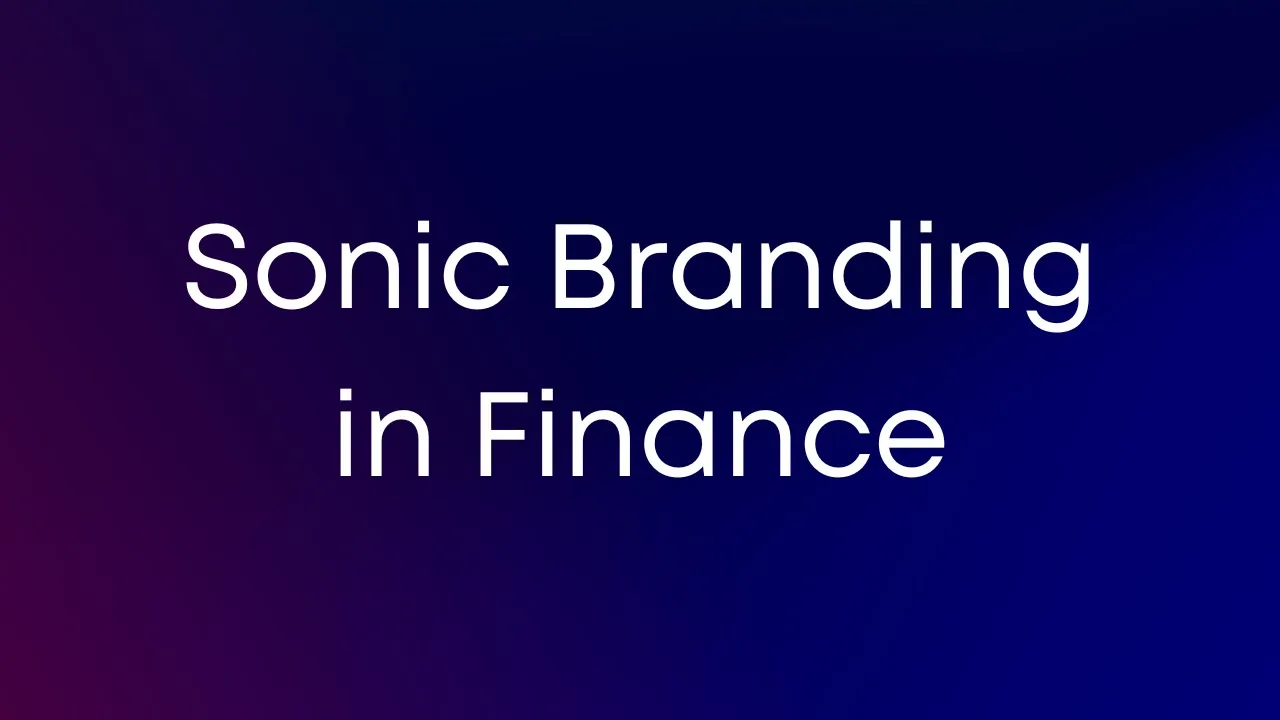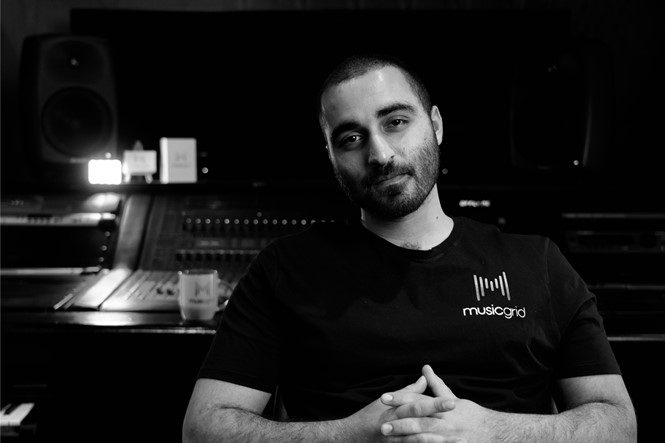Original Music Composition: Your Brand's Sonic Strategy
.jpg)
For large brands operating across the UAE and GCC, music holds real weight. It’s the first impression on a pre-roll ad, the emotional pivot in a brand film, and the lasting imprint after an app interaction. When that sound is built from scratch to match your voice, values, and audience? It doesn’t just fill space. It drives recognition, recall, and trust.
A generic stock track can’t do that.
Original music composition creates something that off-the-shelf tracks cannot: a sense of belonging. A brand sound crafted around your specific identity cues tells your audience exactly who you are—before a single visual hits the screen. That subtle oud accent in a launch film. The signature vocal phrase in a customer service IVR. The rhythmic motif that opens your app. These are fast, repeatable trust signals that embed you deeper into consumer memory.
In GCC markets, consistency matters. Audiences here are sharp. They recognize when music has intent, and when it’s just filler. When your sonic identity aligns with your visual and messaging strategy, it elevates the entire campaign. Not emotionally; practically. It improves measurable brand recall, strengthens marketing efficiencies, and supports brand guidelines across complex, multi-team ecosystems.
Here’s why that matters right now:
- Consumers expect clarity. Generic trailers and TikTok sounds won’t carry a national brand across real channels.
- Brand trust is either earned quickly or not at all. Audio is often the fastest route to emotional alignment. But only if it’s yours.
- Ad campaigns are moving faster than ever. Distinct, reusable brand scores keep pace across every output: outdoor, digital, activations.
Your competitors may still be borrowing from production libraries. That buys them time, not loyalty. If your brand is serious about sticking in memory, from Riyadh openers to Dubai pitch closers, it’s time to speak in your own voice. Literally.
Request a strategy call to hear what your brand could sound like, and why it matters more than ever this year.
Aligning Sonic Identity with Your Brand Strategy
Your music should reflect your brand, not someone else’s.
In the GCC, especially in markets like the UAE, the sound your brand uses is a direct representation of who you are and how seriously you take your message. Original music composition lets that come through with precision. No vague fits or forced moods. Only deliberate pieces that tie directly to your brand values and market positioning.
This isn’t just about “sounding right.” It’s about strategic consistency.
When original compositions are built around your core identity, they create a unified thread across every output. From paid media to internal events, every team works from the same sonic playbook. That means no last-minute re-licensing or unpredictable tone shifts. Just a reliable, recognizable sound language that scales.
Here’s how original music supports your broader brand plan:
- Visual-to-audio alignment across touchpoints. Campaigns in the UAE rarely exist on a single channel. Your music should convey the same energy and emotion, whether it’s used in a retail activation, TV commercial, or app login.
- Strengthens multi-agency coordination. Messaging remains cohesive when external partners or internal departments utilize consistent musical assets that align with your established sonic identity.
- Improves regional relevance. A composition tailored for GCC audiences can nod to local musical traditions while aligning with your larger brand voice.
A cohesive sound isn’t a luxury. It’s infrastructure.
For enterprise brands engaging with audiences across borders, aligning visual, verbal, and musical communication avoids costly incoherence. More importantly, it builds trust. That’s especially critical in this market, where audiences are culturally attuned and quick to sense when something feels off or is imported without care.
Sound is an identity asset, not background material.
When your sonic identity is treated as a cornerstone of brand strategy, not an afterthought, you empower every stakeholder in your ecosystem to tell your story more clearly, from pitch decks to public broadcasts.
Book a strategy call to ensure your audio assets are saying exactly what your brand stands for; everywhere they’re heard.
Scalable Music Assets for Fast-Paced Campaigns
Campaign timelines are tight. Your music workflow shouldn’t slow you down.
Fast-moving campaigns across the GCC require speed, precision, and consistency, particularly in sectors where brand reputation is paramount. A pre-composed, custom library of brand-aligned music isn’t a sunk cost. It’s a long-term asset that unlocks faster production cycles, smoother team handoffs, and audible consistency across your entire media mix.
Here’s how scalable music assets support real-world marketing demands:
- Shorten creative lead times. When your team or agency is working with pre-cleared, pre-aligned music stems, you skip the music briefing, the licensing check, and the guesswork about tone.
- Ensure cross-channel consistency. Your campaign sound doesn’t drift between formats. That same sonic identity works just as well in a digital promo, a retail touchpoint, or a social story ad; because it’s built to flex.
- Streamline collaboration across stakeholders. Whether your campaign involves media planners in Riyadh, event agencies in Jeddah, or content producers in Dubai, everyone pulls from the same reliable source: your original music system.
Custom doesn’t mean complex. It means repeatable.
Well-designed music libraries provide adaptable stems, loops, and motifs that your production partners can utilize without requiring rework. Need a shorter version for programmatic audio? A stripped-down loop for a launch teaser? Your music toolkit covers the bases. And when you need to scale for a brief or regional twist, your composer already knows the boundaries.
This matters in GCC markets, where speed and volume coexist.
Brands here are not launching one campaign per quarter. They’re managing regional rollouts, platform-specific edits, and audience-tailored versions simultaneously. Relying on stock tracks or rushed outsourcing forces expensive compromises on quality, tone, or timeline. A curated audio library removes that tradeoff.
Plan ahead. Build a scalable sound system matched to your brand's pace.
Book a strategy call to explore what a custom music asset library could look like for your brand and how it can reduce production bottlenecks across every campaign touchpoint.
Customization That Speaks to Local Culture and Consumer Preferences
To stand out in this market, your music must feel familiar, and still feel like you.
GCC audiences value cultural authenticity. It’s not a bonus. It’s the baseline. Generic production tracks often fall short, sounding either too international or too bland, and fail to resonate. Original music composition gives your brand the flexibility to integrate intentional cultural cues that are recognizable, respectful, and relevant to the region.
Brand sound doesn’t exist in a vacuum. It’s judged in context.
When your score includes sounds your audience knows, such as a rhythmic pattern rooted in Khaleeji traditions or instrumental textures featuring oud, qanun, or ney, it signals care. It tells listeners you’re speaking their language, not just selling a slogan. That kind of connection builds faster trust and deeper recall.
Key Elements to Tailor for This Market
- Rhythmic identity: Use percussive patterns that reflect GCC musical timing, energy, and transitions, especially for branded stingers or app sound cues.
- Instrumental palette: Blend traditional sounds (like Arabic woodwinds or strings) with your established audio tone. Keep it aligned with your sector and audience expectations.
- Melodic motifs: Create simple, repeatable phrases that feel both modern and culturally informed. These motifs are consistent across ads, events, and even internal communications.
Sound familiarity breaks audience resistance. Cultural nuance strengthens brand clarity.
This isn’t about inserting a regional instrument just for effect. It’s about building a sonic architecture that feels natural to local ears while still reinforcing your brand values. That’s what creates brand affinity in a competitive market.
Whether your audience is browsing a retail rollout in Doha or listening to a radio spot during their commute in Abu Dhabi, their brains quickly filter the sound. If it aligns with their cultural expectations and emotional context, it is processed and stored. If not, it’s ignored or forgotten.
Don’t settle for “close enough.” For corporate brands working across GCC audiences, especially in the UAE, your music should be as regionally fluent as your campaigns already are.
Book a strategy call to explore how your brand can use music that speaks to your market, not just about it.
Integrating Original Music Into Your Marketing Mix for Measurable Impact
Music is only effective when it’s used with intention and consistency.
For corporate brands in the UAE and broader GCC, a tailored sonic identity shouldn’t live in a campaign folder. It belongs inside your marketing system, guiding the sound of every touchpoint. Whether it's a corporate video, mobile app, in-store playlist, or audience-led activation, original music only delivers results when it’s embedded into the workflow, not bolted on at the final hour.
If you’ve invested in getting your brand sound right, here’s how to use it across the board:
1. Standardize Sound Across Brand Touchpoints
- Start with your brand guidelines. Ensure the audio identity has its own documented section, complete with usage rules, tone guidance, and available variations (e.g., intro stings, service hold music, ad beds).
- Add approved audio stems to your media kits. Treat them like logos and fonts. Agencies and in-house teams should know exactly which files to use and when.
- Ensure compatibility across formats. Whether a client hears your sound on the radio, social media, or in your retail space, it should all convey a unified, cohesive brand voice. No tonal whiplash.
2. Sync Audio Strategy with Content Calendars
- Include music strategy in campaign briefs from day one. Don’t let video editors or platform teams improvise at the finish line. Directional clarity up front avoids tone mismatches later.
- Tag assets by use case. Clearly mark what works best for explainer videos, fast-paced reels, or VIP event teasers. Your team shouldn’t have to guess.
3. Activate Music During Experiential Moments
- Reinforce branding in physical environments. Use variations of your custom composition at exhibitions, product launches, or sponsored events. If someone’s walking into your booth in Riyadh or seeing your installation in Dubai, recognizable audio seals the experience.
- Adapt live sound to match campaign tone. Have performance or ambient versions ready for live activations. Don’t rely on stock playlists that blend you in instead of setting you apart.
Embedded music isn't loud; it’s aligned.
When original compositions are deployed thoughtfully, they move past mood-setting. They become part of your brand’s muscle memory. That’s how you reach measurable recall. It’s not just about people liking the sound; it’s about them knowing it’s yours the moment they hear it.
Schedule a strategy call to clarify where your music is lacking, and map out a practical rollout across key channels.
Selecting the Right Partners for Corporate Music Composition
Choosing who composes your brand sound isn’t just creative; it’s operational.
If you're overseeing marketing for a UAE enterprise or directing large-scale campaigns for GCC clients, then reliability, speed, and cultural precision matter just as much as musical talent. The partner you choose to create original compositions needs to deliver more than just a beautiful score. They need to bring business-grade thinking and regionally relevant expertise to the table.
What to Look for When Evaluating Music Providers
Many audio vendors focus solely on the music itself. That’s not enough. Your context demands more.
- Clear understanding of enterprise dynamics. Your chosen partner must be fluent in cross-team alignment, adhere to strict timelines, and navigate layered approvals. This isn’t a solo artist project. It’s commercial infrastructure.
- GCC market fluency. Composers (or the agencies managing them) should know how to reflect regional nuances without resorting to stereotypes. That means understanding cultural harmony structures, instrument choices, and what resonates in KSA versus the UAE.
- Track record with scalable delivery. One catchy melody won’t cut it. Look for teams that can build systems, modular arrangements, adaptive stems, and reusable motifs, built for campaign-scale velocity.
Use a Practical Vetting Framework
Before signing with a composer or agency, assess them with a tangible checklist:
- Experience with corporate briefs: Have they worked in contexts where brand guidelines, turnaround speed, and stakeholder alignment matter?
- Sound clarity samples: Can they demonstrate multiple audio touchpoints from a single brand while maintaining consistency and coherence?
- Localization skill set: Do they have in-house or collaborative access to instrumentalists and consultants familiar with the region’s sonic preferences?
- Flexible licensing terms: Are their usage rights clearly defined for global scale, multi-platform integration, and internal reuse?
In this region, audio details don’t go unnoticed. GCC audiences know when sound is intentional, and when it’s not.
That’s why shortcuts won’t work. And why do you need a music partner whose process includes planning for scale, not just one-off inspiration? The wrong creative vendor might deliver a great jingle. The right one equips your entire ecosystem with a sound identity that works repeatedly; on brand, on budget, and always on time.
Ready to evaluate your next composer or agency? Book a strategy call to clarify what to look for, what to avoid, and how your brand can build a trusted, sound partnership that lasts.
Next Steps to Establish Your Brand's Sonic Identity
If your brand sound still feels like an afterthought, it’s time to fix that.
You’ve seen what original music can do: build recognition, express brand values, ease creative collaboration, and connect with local culture. But without a clear plan in place, those benefits stay locked in theory. This is where decision-makers step in and take a strategic approach.
A solid audio identity starts with knowing where you stand.
Most GCC-based brands already have some audio touchpoints in play. A hold track here. A launch video there. But without cohesion or clear intention, they won’t reinforce each other. The first step is to audit those assets and determine what’s working, what’s missing, and what needs to evolve.
A Practical 3-Step Action Plan
- Schedule an expert strategy call. This is not just a sales pitch. It’s a working session to review your current sound use, identify misalignment across channels, and recommend next steps specific to your market and brand needs.
- Evaluate your current asset library. Gather every piece of audio your company has used in the last timeframe, from app pings to campaign backing tracks. Check them against your visual and verbal brand guidelines. Does it all match? If not, mark the gaps.
- Define your sound pillars. Your identity doesn’t need to be complex, but it does need to be consistent. Agree on core musical elements, tone, rhythm, and instrumentation, and document them in your brand playbook, just as you would your colors, fonts, or imagery.
This isn’t just fixing a sound. It’s designing a system.
By taking action now, you build an infrastructure that supports every campaign to come, regardless of agency or platform. The result is less friction for your teams, more clarity for your consumers, and deeper trust in every interaction. In fast-paced GCC markets, that kind of alignment isn’t just helpful; it's essential.
Book your expert strategy call to review your existing audio assets, map the right next steps, and start shaping a sound that aligns with your brand's ambitions across the GCC.
Stay Tuned – Get the Latest in Sonic Branding

.svg)
Our Blog
.png)

.png)



.png)
.png)
.png)
.png)
.png)

.jpg)
.jpg)
.jpg)
.jpg)
.jpg)
.jpg)
.jpg)
.jpg)
.jpg)
.jpg)
.jpg)

.jpg)

.jpg)
.png)
.png)

.jpg)
.png)
.png)
.png)
.jpg)

.jpg)
.png)


.png)
.png)


.png)
.jpg)
.jpg)
.jpg)

.png)

.svg)
.svg)


.svg)
.svg)

.svg)


.svg)